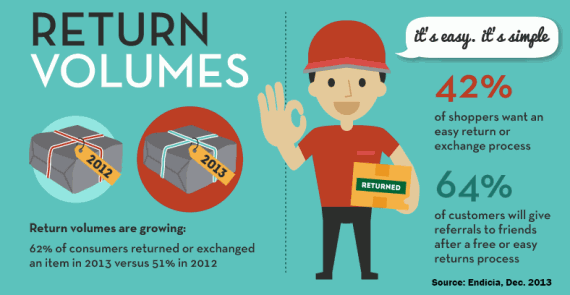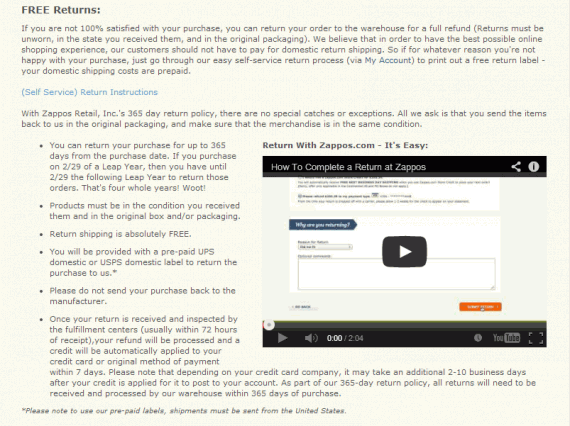More than 60 percent of online shoppers returned or exchanged at least one item in 2013, up from about 51 percent in 2012. Importantly, about 95 percent of customers will go back to a online merchant and make additional purchases after a positive return or exchange experience, making managing the process important for ecommerce success.
Exchanges and returns will shortly be a hot topic for online retailers as Christmas gift recipients contact sellers in the wake of an exceptional holiday selling season. These Christmas gift recipients will want to exchange and return unwanted gifts, items that are the wrong size, or even items that may have been damaged in transit.

Endicia, the postage provider, reports that returns and exchanges are increasing for online merchants.
comScore, the trend tracking firm, reported yesterday that desktop ecommerce (excluding travel and mobile ecommerce) totaled about $37.8 billion in the U.S. for the first 45 days of the Christmas shopping season. Total spending since Thanksgiving, comScore reported, has been up about 21 percent over 2012, reaching $19.2 billion in U.S. desktop ecommerce spending for the period. This increase in sales will also represent an increase in returns and exchanges.
Returns and exchanges are important for building long term customer relationships, with some 95 percent of shoppers going back to online merchants that have offered a good exchange or return experience in the past, according to data from Endicia, an electronic postage solution provider. Conversely, about 85 percent of consumers will not return to an online shop after a poor return or exchange experience, again according to Endicia.
What follows are four tips for offering a better exchange or return experience for online shoppers.
1. State Return and Exchange Policies Clearly
Let customers know exactly what to expect from the return and exchange process. Post clear, simple-to-understand policies on a page of the site specifically designated for returns or shipping policies.
Online retailer Zappos is an excellent example of how to make returns seem easy for shoppers. The company has a dedicated returns page, lists its policy in bullet points, and even includes a video that explains how to complete a return using Zappos’ self-service model.
It is worth noting a couple of things about Zappos’ return policy. First, every return is free. While each individual online retail business will need to examine the financial impact of a free return policy, taking the expense out of sending back an item can go a long way toward making loyal customers for life.
Zappos also offers to accept returns with no questions asked for up to a year after the purchase.
2. Provide Return Instructions or a Return Label in Every Order
Shoppers don’t want to wait for return labels. In fact, about 62 percent of online shoppers want a return label included in the initial shipment, according to Endicia. Including a return label is not difficult, and many online sellers may find that the ability to do so is either built directly into the retailer’s ecommerce platform or is available via an extension to the ecommerce platform.
A second option may be to offer shoppers a simple, self-service way to print a return label from your site. This self-service option does not require the customer to contact the shipper to get authorization or wait for an emailed label. According to the Endicia data, about 61 percent of shoppers will be happy with an easy way to print return or exchange labels.
3. Know the Cost of Returning
A guitarist for a popular party and event band recently ordered a new guitar strap from a merchant on the Amazon marketplace. Unfortunately, there was an error in the shipment, and the merchant apparently sent a shorter strap than expected. When this guitarist contacted the seller about an exchange, he was told that a new strap would be shipped that day and that he could simply keep the smaller strap.
This solution was great for the customer, who did not have to repackage the strap or arrange for a carrier to pick it up. He was generally happy with the experience. This was probably also better for the merchant, who might have simply been able to order a new guitar strap from its distributor for about the same cost has having the strap returned.
To make this sort of business decision, it is important to understand the real cost of managing a customer return, including the cost of the shipping and the labor necessary for processing the return once it arrives back at the seller’s warehouse. If it cost as much or nearly as much to return the item as it would to simply purchase another one wholesale, consider letting the customer just keep it, saving everyone involved time and expense.
4. Create an Opportunity
Returns and exchanges are also an opportunity to make additional sales. As mentioned above, about 95 percent of shoppers will return to an online store and make an additional purchase after a positive return or exchange experience.
Similarly, about 45 percent of shoppers will actually recommend an ecommerce merchant, again according to Endicia, after a positive return experience, meaning that taking care of an existing customers could lead to new customers too.
Consider sending each shopper who returns or exchanges an item a follow-up email, asking for feedback about the experience. Identify ways to improve the return process, and business in general will improve too.





